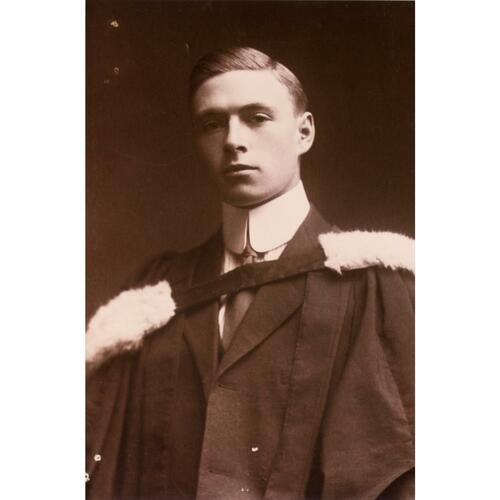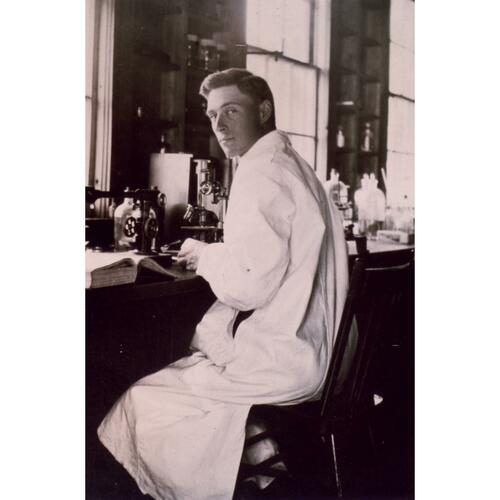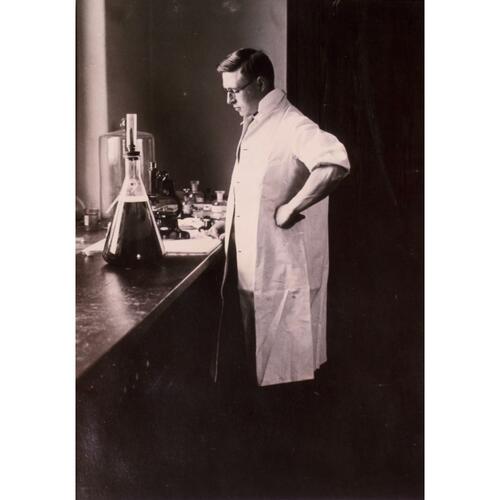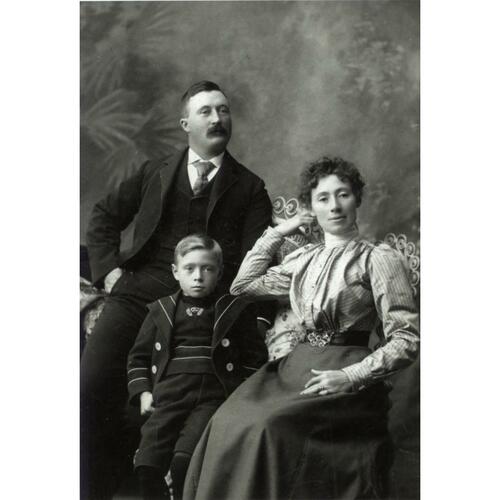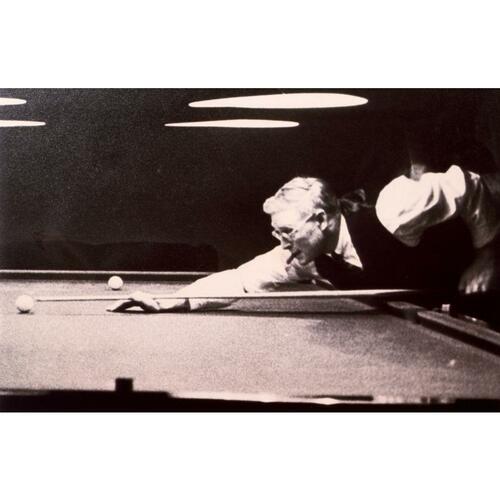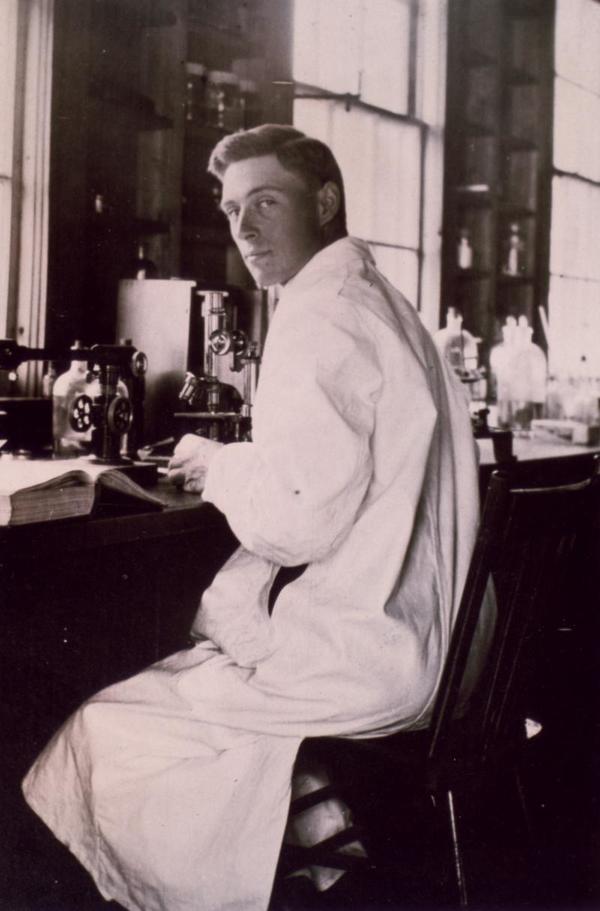
Source: Link
COLLIP, JAMES BERTRAM, biochemist, endocrinologist, university teacher, medical-research administrator, and office holder; b. 20 Nov. 1892 in Belleville, Ont., elder of the two children and only son of James Dennis Collip, a gardener and florist, and Mahala Frances Vance, a schoolteacher; m. 28 Dec. 1915 Ray Vivian Margaret Ralph in Dundas, Ont., and they had two daughters and a son; d. 19 June 1965 in London, Ont.
James Bertram Collip, known to his family and friends as Bert, attended a one-room country school and Belleville High School, where he developed an interest in science, particularly chemistry. In 1908 he entered Trinity College, which had recently federated with the University of Toronto. Because, at the age of 15, he was too young to pursue the medical course as he had intended, he enrolled in honours physiology and biochemistry, a program that provided rigorous training in original research for an elite stream of medical students. Collip received a ba in 1912 and graduated at the head of his class. He then undertook studies in biochemistry with Archibald Byron Macallum* and earned an ma in 1913 and a phd three years later for his research on the formation of hydrochloric acid in the vertebrate stomach. During his student days he met Ray Ralph, who was an arts student at Trinity College; they married in 1915.
That year Collip was appointed a lecturer in biochemistry in the department of physiology at the University of Alberta, where he would carry on an active research program on the blood chemistry of vertebrates and invertebrates. After the close of World War I he was awarded a Rockefeller Travelling Fellowship that allowed him to go elsewhere during his sabbatical year in 1921–22. In April 1921 he returned to the University of Toronto on the first stop of his intended journey, which was also to take him to New York and England, and began studies with John James Rickard Macleod*, a renowned authority on carbohydrate metabolism. After a summer spent visiting marine biological stations at Woods Hole, Mass., and St Andrews, N.B., Collip, with his wife and young family, settled in Toronto for the autumn.
In December he was asked to contribute his skills as a biochemist to a promising research project that was being carried out under Macleod’s supervision. Frederick Grant Banting*, a physician from London, Ont., and Charles Herbert Best*, a student in the honours physiology and biochemistry program, were searching for the active principle of the pancreas, which Banting believed could be used to treat diabetes mellitus. Over the summer and autumn of 1921 they had successfully made an extract, first from dogs and later from cattle, that could lower blood sugar. However, this preparation proved to be unsuitable for clinical use because its impurities caused undesirable side effects, especially the formation of a sterile abscess at the site of the subcutaneous injection. Banting and Best definitely had an anti-diabetic agent in their extract, but they had achieved no more than other researchers before them, notably Georg Ludwig Zuelzer (1908), Ernest Lyman Scott (1912), Israel S. Kleiner (1919), and Nicolas Constantin Paulescu (1921).
Recognizing the need for a more purified product, Banting asked Macleod to invite Collip to join in the work. On 19 Jan. 1922 Collip prepared an extract by using increasing concentrations of alcohol. He found that impurities were thrown down at up to 80 per cent ethyl alcohol and that the active principle precipitated out in pure form at around 95 per cent alcohol. This extract was the first one suitable for clinical use, as was demonstrated in a successful trial on diabetic patient Leonard Thompson on 23 January.
Collip also made key physiological observations. First, he described acute hypoglycaemia in normal rabbits that were given a dose of the extract; the animals suffered convulsions and then became comatose. He demonstrated that this effect was the result of dangerously low blood sugar and that it could be corrected by the injection of a glucose solution. Because of this finding, Collip was able to warn clinicians of the dangers of hypoglycaemia following too-high doses of the extract. As well, he developed a biological assay for the preparation by measuring its effect on the blood sugar of normal rabbits, which meant the extract could be standardized more easily and economically than by using depancreatized dogs. Secondly, he showed that glucose in the blood was converted to glycogen in the liver following administration of the extract. This outcome was proof that the extract replaced a physiological function that was missing in the diabetic patient. Finally, Collip demonstrated that ketones in the blood and urine were eliminated when the extract was used.
These pieces of evidence were crucial because Banting and Best had demonstrated only the extract’s effect in reducing glucose in blood and urine; however, lowered sugar output might be the result of other conditions, such as a reaction to toxic elements in the extract, rather than replacement of the actual function of the pancreas. In providing a non-toxic anti-diabetic extract suitable for therapeutic use and in describing key physiological properties of the active principle’s action, Collip extended the work of the Toronto group beyond what had been accomplished by other researchers and provided convincing proof of the product’s value in treating diabetes. Unfortunately, relations among the discoverers became fraught, as Banting grew anxious that Macleod and Collip were taking credit away from him. An angry confrontation broke out when Collip announced that he had purified the extract but refused to divulge his method, having been advised by Macleod and others to keep it secret until it had been fully tested.
Initially, quantities of the product were frustratingly small, even as demand for it grew when news of the team’s success spread. The researchers worked with the University of Toronto’s Connaught Antitoxin Laboratories, under John Gerald FitzGerald*, to increase production of the extract, which was given the name insulin. Later it became clear that more resources were needed, and the pharmaceutical firm Eli Lilly and Company of Indianapolis, Ind., collaborated with the Toronto group to manufacture insulin on a commercial scale. A patent was taken out in 1922 in the names of Banting, Best, and Collip and turned over to the University of Toronto’s board of governors to manage. Royalties were split: half was directed to the university for a research fund and the rest divided among the three researchers for the support of their work wherever they went in Canada. This arrangement, together with grants from several organizations, meant that Collip had access to what would be the largest ongoing funding for medical research available in the country at the time.
Banting and Macleod were awarded the Nobel Prize in Physiology or Medicine in 1923. Banting announced that he would share his award money with Best, and Macleod followed suit by stating that he would share his with Collip in recognition of the young researcher’s role in the discovery. Collip had given up his Rockefeller fellowship in early 1922 to remain at the University of Toronto until the end of his leave. When he returned to the University of Alberta later that year, as a full professor and head of the department of biochemistry, he moved away from general research in that field and would thenceforth focus exclusively on the identification and isolation of hormones of therapeutic value. To further his work in this new area, he enrolled in medical school as a part-time student and earned an md in 1926, while continuing to serve as a faculty member. He had been awarded a dsc two years earlier for his research accomplishments.
A skilled laboratory biochemist, Collip was a leading researcher in endocrine science during the 1920s and 1930s. His most important contribution in the first years after the insulin discovery was the isolation in 1924 of the parathyroid hormone, which could be used to treat parathyroid tetany. Collip and chemist Earl Perry Clark provided evidence that this hormone regulates serum calcium and that low levels of calcium in the blood result in tetany. They also developed a method for measuring serum calcium that would be standard in laboratories for decades. However, as a result of his research, Collip found himself embroiled in a dispute over priority with Minnesota physician Adolph Melanchthon Hanson, who in 1923 had published a method of preparing an extract of the parathyroid gland using hot hydrochloric acid, a year earlier than Collip’s paper describing the same procedure. In 1932 Hanson was awarded the American patent for the product and process of extracting the principle of the parathyroid gland. Yet Collip is generally recognized by the scientific community for isolating the hormone, providing physiological proof of its activity, and contributing to the growth of the scientific study of the parathyroid.
In 1928 Collip, having turned down an offer from the prestigious Mayo Clinic in the United States, was appointed to the chair of biochemistry at McGill University, succeeding his mentor A. B. Macallum. There he headed a large, thriving research team that included David Landsborough Thomson, Hans Hugo Bruno Selye*, and graduate students John Symonds Lyon Browne, Evelyn M. Anderson, and Leonard Irving Pugsley*. Throughout his career he was ably assisted by his loyal factotum, Arthur Long, who had joined his laboratory at the University of Alberta after the war and followed him to McGill and, later, to the University of Western Ontario.
The field of endocrinology was burgeoning in the 1930s, and there was tremendous scientific interest in the sex hormones and in the pituitary gland, which was understood to be the master gland controlling the function of several others. An interdisciplinary approach was necessary. Collip, the biochemist, provided the extracts by distilling the active principles from the raw materials. Selye, the histologist, was skilled in surgical techniques and mastered the difficult preparation of the rats to be used as test animals by removing their pituitaries via a parapharyngeal route. He also supplied the histological studies that were required when the hormones associated with growth and development were studied. The biochemical and physiological functions of Collip’s extracts were explored by other members of the team. The McGill group and several laboratories around the world were actively involved in extracting various components of the anterior pituitary gland and describing their functions; they identified hormones that stimulated the thyroid, the adrenal cortex, and growth. Collip, Anderson, and Thomson prepared a crude but active extract of adrenocorticotropic hormone (ACTH) in 1933 that was sufficiently pure for clinical use.
Collip was entrepreneurial in expanding and sustaining his research ventures by negotiating with administrators, finding private donors, and forging alliances with business enterprises. In 1930 he had isolated what he called Emmenin, a form of estriol from the placenta that was commercially significant because it could be administered by mouth. He collaborated with the small Montreal pharmaceutical firm Ayerst, McKenna and Harrison, which expanded its research and manufacturing operations to advance this product. Later the Ayerst researchers would develop a different orally active estrogen from pregnant mares’ urine called Premarin. Used in hormone replacement therapy for the treatment of menopausal symptoms, it became one of the top-selling pharmaceutical products in the second half of the 20th century and established Ayerst as a major player in the field. The company advertised that Emmenin and Premarin had been standardized in Collip’s laboratory and paid royalties on both products, providing the lab with considerable research funds for decades, which were particularly important at a time when government support had not yet begun and when researchers were dependent on private donors and foundations.
Collip was known for his restless nature and for the speed with which he thought, spoke, and made decisions. Students and associates fondly remember his habit of driving very fast, and a car trip with him was, a colleague remarked, akin to “a form of low flying.” During the McGill years Collip spent long hours at his large distillation units, making extracts from huge numbers of glands provided by the slaughterhouse and placentas supplied by the maternity hospitals. He rushed back and forth adjusting this or that mixture, smoking large hand-rolled cigarettes, and dropping ashes on his vest. Many students and postdoctoral fellows passed through the lab and thrived in the atmosphere of enthusiasm and productivity. Collip relished this environment and was full of ideas when something captured his interest, but he let his co-workers and students pursue their own projects. He had a lifelong habit of working late into the night, and his wife, Ray, often came in to keep him company. A gracious and supportive partner throughout their marriage who was familiar with her husband’s penchant for quick changes in plans, she learned to keep a suitcase packed and ready. In later years his younger daughter, Barbara Vivian, joined him in the lab and sometimes found herself sitting with a dropper and instructions not to let something boil over.
Between 1938 and 1957 Collip took a leading role in establishing federal coordination and funding of medical research through the National Research Council of Canada (NRC). In the mid 1930s he had become reconciled with Banting, and when Banting organized the Associate Committee on Medical Research for the NRC in 1938, he asked Collip to join. Collip was the last friend and colleague to see Banting before he died following a plane crash in 1941. After his death, Collip assumed leadership of the medical-research arms of the NRC, including the heavy wartime responsibility of overseeing associate committees for each of the three branches of the armed forces and serving as Canada’s medical liaison officer to Washington. He was an acting lieutenant-colonel in the Royal Canadian Army Medical Corps from 1942 and acting colonel from 1944. When the Division of Medical Research replaced the Associate Committee on Medical Research in 1946, he was appointed its first director, and he helped to shape government support for work across the country. Because of Canada’s small population, Collip argued against building national laboratories like those in Britain and the United States; instead he promoted grants-in-aid for research at universities and teaching hospitals.
A Gilman Cheney chair in endocrinology had been created for Collip at McGill in 1937, and four years later, at his urging, the university established the Research Institute of Endocrinology. But in 1947 he accepted an invitation to become dean of medicine at the University of Western Ontario in London. He enjoyed the challenge of building up its medical school during an era of active expansion. He was also professor and head of the department of medical research, though he was no longer actively involved in such work. At the Collip Medical Research Laboratory in 1958 his long-time associate Robert Laing Noble, who had followed him to Western, and biochemist Charles Thomas Beer isolated vinblastine, a drug that became one of the key elements in combination chemotherapy for cancer.
Collip received many honours during his career. He was made a commander of the Order of the British Empire in 1943 and awarded the American Medal of Freedom with Silver Palm four years later for his war efforts. He had been elected a fellow of the Royal Society of Canada in 1925 and served as its president in 1942–43. He was also a fellow of the Royal Society of London from 1933. He went on to win the Flavelle Medal of the Royal Society of Canada and the F. N. G. Starr Award of the Canadian Medical Association in 1936, the Cameron Prize from the University of Edinburgh in 1937, the Charles Mickle Fellowship Award from the University of Toronto in 1941, and the Banting Medal for Scientific Achievement of the American Diabetes Association in 1960. Twelve honorary degrees were conferred on him by universities in Canada, Britain, and the United States. Collip retired from the NRC in 1957 and as dean of medicine four years later. He remained head of the Collip Medical Research Laboratory and continued to be interested in its activities, but he never went back to the bench himself. He died of a stroke at the age of 72, two days after returning home from a cross-country trip with Ray to attend the annual meeting of the Royal Society of Canada in Vancouver.
Skilled both as a laboratory scientist and as an entrepreneur, James Bertram Collip was a pioneering researcher in endocrinology and a leader in the development of Canadian medical research. He was at the forefront of the institutional transformation of medical science, which, in the opening decades of the 20th century, had been the pursuit of a select few but which, by mid century, had grown into a large-scale, systematic venture that involved teams of professional scientists and dozens of laboratories in universities, government, and industry. Collip’s role in the insulin discovery was recognized by only a small circle and largely forgotten by the general public, who credited Banting and Best with the achievement. In recent decades, however, the critical importance of his work to the success of the Toronto group has become more widely acknowledged. He found the bitter conflict associated with the discovery distasteful. Known for his integrity, modesty, and quiet nature, Bert Collip always refused to discuss the insulin days, saying only that he was sure the historical record would speak for itself.
James Bertram Collip has a full-length biography in Alison Li, J. B. Collip and the development of medical research in Canada: extracts and enterprise (Montreal and Kingston, Ont., 2003). M. L. Barr and R. J. Rossiter, “James Bertram Collip, 1892–1965,” Royal Soc. of London, Biog. memoirs of fellows, 19 (1973): 235–67, an excellent account of his life, also contains a bibliography of Collip’s published work. Short biographical sketches and reminiscences of the scientist can be found in J. S. L. Browne and O. F. Denstedt, “James Bertram Collip (1892–1965),” Endocrinology (Philadelphia), 79 (1966): 225–28; D. A. Keys, “James Bertram Collip …: an appreciation,” Canadian Medical Assoc., Journal (Toronto), 93 (1965): 774–75; R. L. Noble, “Memories of James Bertram Collip,” Canadian Medical Assoc., Journal, 93 (1965): 1356–64; and R. J. Rossiter, “James Bertram Collip, 1892–1965,” Royal Soc. of Can., Trans. (Ottawa), 4th ser., 4 (1966), proc.: 73–82.
Michael Bliss reveals crucial details of Collip’s role in the events of 1921–22 in The discovery of insulin (Toronto, 1982; 25th anniversary ed., 2007), and he evaluates the scientist’s legacy in “J. B. Collip: a forgotten member of the insulin team,” in Essays in the history of Canadian medicine, ed. Wendy Mitchinson and Janice Dickin McGinnis (Toronto, 1988), 110–25, and “Rewriting medical history: Charles Best and the Banting and Best myth,” Journal of the Hist. of Medicine and Allied Sciences (New Haven, Conn.), 48 (1993): 253–74. Collip’s itemized list of his contributions to the insulin research was published in “Banting’s, Best’s, and Collip’s accounts of the discovery of insulin,” intro. Michael Bliss, Bull. of the Hist. of Medicine (Baltimore, Md), 56 (1982): 554–68.
Collip’s research on the physiology of the parathyroid hormone is examined in T. B. Schwartz, “Giants with tunnel vision: the Albright-Collip controversy,” Perspectives in Biology and Medicine (Chicago), 34 (1991): 327–46, which focuses particularly on his disagreement with American endocrinologist Fuller Albright. Virginie Marier and Tina Piper describe the scientist as an innovator in the development of business models for the commercialization of medical science and the protection of intellectual property in “Early twentieth-century Canadian medical patent law in practice: James Bertram Collip and the discovery of Emmenin,” Univ. of Toronto Law Journal, 60 (2010): 855–91.
Arch. of Ont. (Toronto), RG 80-2-0-379, no.12682; RG 80-5-0-812, no.16756. McGill Univ. Arch. (Montreal), RG 38 (Faculty of Medicine). Univ. of Alta Arch. (Edmonton), Henry Marshall Tory fonds. Univ. of Toronto Libraries, Thomas Fisher Rare Book Library, ms coll. 269 (James Bertram Collip papers). Western Univ. Arch. (London, Ont.), James Bertram Collip fonds.
Cite This Article
Alison Li, “COLLIP, JAMES BERTRAM,” in Dictionary of Canadian Biography, vol. 19, University of Toronto/Université Laval, 2003–, accessed January 19, 2025, https://www.biographi.ca/en/bio/collip_james_bertram_19E.html.
The citation above shows the format for footnotes and endnotes according to the Chicago manual of style (16th edition). Information to be used in other citation formats:
| Permalink: | https://www.biographi.ca/en/bio/collip_james_bertram_19E.html |
| Author of Article: | Alison Li |
| Title of Article: | COLLIP, JAMES BERTRAM |
| Publication Name: | Dictionary of Canadian Biography, vol. 19 |
| Publisher: | University of Toronto/Université Laval |
| Year of revision: | 2018 |
| Access Date: | January 19, 2025 |




